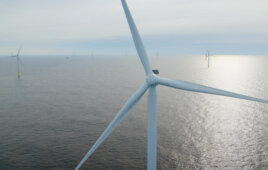Running the world on 100% renewable energy would mean building about four million, 5-MW wind turbines, 1.7 billion, 3-kW roof-mounted solar photovoltaic systems, and about 90,000, 300-MW solar power plants. Mark Delucchi, one author of the report published in the journal Energy Policy, said his team wanted to show that enough renewable energy could be harnessed to meet demand indefinitely by 2030.
Delucchi and colleague Mark Jacobson left all fossil fuel sources out of their calculations and concentrated on wind, solar, waves, and geothermal sources. Fossil fuels currently provide over 80% of the world’s energy supply. The authors also omitted biomass, the most widely used renewable energy source, because of concerns regarding pollution and land-use issues. Calculations also left out nuclear power, which currently supplies about 6% of the world’s electricity.

Four million, 5-MW wind turbines and a few solar panels will be needed to reach energy independence by renewable energy, say study authors.
The authors admit a great deal of building would be needed. Wind turbines, for example, would have to be two to three times the capacity of most of today’s units. However, 5 MW offshore turbines have been built in Germany since 2006, and China built its first in 2010. Solar power plants would be a mix of photovoltaic panels and concentrated solar facilities which would boil water to drive generators. Presently only a few dozen such utility-scale solar plants exist. Photovoltaic panels would mount on most homes and buildings.
Jacobson said the big challenge comes in connecting variable supplies, such as wind and solar, so different renewable sources could work together to match supply with demands. More consistent renewable sources of wave and tidal power and geothermal systems would supply less of the energy but their consistency would make the whole system more reliable.
Delucchi comes from the Institute for Transportation Studies at U Cal, Davis, while Jacobson works at Stanford University’s Department of Civil and Environmental Engineering. They say all the major resources needed are available. The only bottleneck would be supplies of rare earth materials such as neodymium, which is used to manufacture magnets preferred in direct-drive turbines. This bottleneck could be overcome if mining were increased by five fold and recycling introduced, or if research programs were to develop a material as good as neodymium. Political bottlenecks, however, may be insurmountable.
Windpower Engineering
www.windpowerengineering.com
Filed Under: Community wind, Offshore wind, Projects




